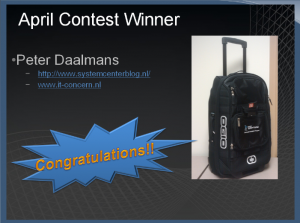During this high level meeting about the new Application Model in Configuration Manager 2012 an earlier session was repeated. In this blog I will be a summary about this session and most of the information can also be found in the slide deck of the session.
Nevertheless, Microsoft invested big time to create a new application model where the user can be the center of the deployment / management of the applications. In my opinion, this worked out well and Configuration Manager is going to be a mature configuration management platform.
Last but not least, I won the monthly price of the Community Evaluation Program, thanks guys!
Application Model Diagram
Like I wrote a couple of times, the Application Model within Configuration Manager is drastically changed. The key elements are listed below;
- Administrator properties (Keep your apps organized and managed)
- End User metadata (user friendly information for you users)
- Deployment Type (workhorse for application)
- Requirement Rules (can/cannot install application)
- Dependencies (applications that must be present)
- Detection method (is the application installed?)
- Install command (command line and options)
- Content (source files for the applications)
How does Configuration Manager 2007 compare to Configuration Manager 2012 Application Model:
| Configuration Manager 2007 | Configuration Manager 2012 |
| Package | Application and Deployment Types |
| Program | |
| Advertisement (Install Status) | Deployment (state based) via detection method |
| Collection rules (Server) | Requirement rules (Client) |
| None | User Device Affinity |
| Run Advertised Programs | Software Center |
| None | Software Catalog |
| None | Single Instance Content Management |
App-V in Configuration Manager, what is changing?
App-v is fully part of the Application Model and part of Configuration Manager 2012. Configuration Manager 2012 with app-v will fully support the VDI solution of Microsoft Hyper-and Citrix XenDesktop. At this time you still need a separate client but I asked the guys from the Beta2 program if the App-V client cannot be part of the Configuration Manager Client.
- Integration requires App-V 4.6 client
- New Application Model, User-centric features
- Enable support for application dependencies
- Improved update behaviors
- Selective publishing of components
- Dynamic Suite Support
- Instant icon gratification for unlock events
- Integration with Remote Desktop Services (TS)
- Content Improvements
- Streaming improvements
- Reduce virtual app footprint when using Download and Execute
Software to Mobile Devices
Software to Mobile Devices is simplified and part of the application model. Configuration Manager offers a unified easy way to manage software distribution experience for users and administrators.
- Software – automatically installed on devices as “required” deployment
- End-User – automatically associated with their device (UDA)
- Administrator – Maintains a unified deployment and monitoring administration experience.
Dependencies
When deploying applications you can define application dependencies. A dependency can be another required application to be installed.
- Other deployment types that must be present in order for the current application deployment type to be installed
- You can build 1 to n dependencies
- This AND this AND this OR this
- Dependencies are modeled as applications and can also be deployed independently
Deployment
Deploying applications says it all. J
- Replaces the “Advertisement” from Configuration Manager 2007
- Is created when an Application is deployed to a Collection
- Applications are state based and only deploy to a collection once
- Two types of deployment purposes
- Required
- Available
- § Available for User targeted displayed in the Software Catalog
- § Available for Device targeted displayed in Software Center on client
- Provides setting for “Pre-deployment” feature when targeting user or user security group collections
On demand installation process
- 1. User clicks install on the item in the software Catalog
- 2. Web Site checks users permissions to install
- 3. Web site requires client id from Configuration Manager Client agend and passes it to the site server
- 4. Server creates policy for the specified client and application and passes it to the client
- 5. Client agent evaluates requirements from the policy and initiates the installation
- 6. Client agent completes the installation process and reports status
Detection Methods
- Detection methods enable systems to determine whether or not an application is already present on the system (Discovery)
- In Software Updates world, this is known as IsInstalled
- Many system attributes play into presence of an application on a system (registry, file versions, MSI, WMI, etc)
- Detection is the key to any state based software distribution system.
A deployment rule can have the following rule types:
- File system rules
- Registry rules
- Windows Installer
All the rules can be combined in detection expressions. Any combination with logical operators AND and OR can be used to create complex rule sets.
Requirement Rules
- Properties of users and/or devices that makes delivering software appropriate
- Rules are defined per deployment type
- Rules are evaluated in real-time on the client
- Rules are evaluated before the content is downloaded to the client
The following requirement rules can be set:
| Type | Global Condition Name |
| Machine | Machine Operating System and Architecture
Machine Operating System Language
Total Physical Memory
Free disk space
(system, admin defined partitions or any) Machine AD Organizational Unit (OU)
Machine AD Site
ConfigMgr Assigned Site
CPU clockspeed/frequency
# of processors
Screen resolution
|
| User | Primary Device |
| Custom | Create new
Simple conditions
Complex conditions (expressions)
|
What is User Device Affinity?
- Is the key to helping our customers move to
- User Centric Software Distribution
- Provides the ability to define a relationship between a user and a device
- Allows the admin to think “user first”, while also ensuring the application
not installed everywhere the user logs on
- Configuration Manager 2012 supports:
- Single primary user to primary device
- Multiple primary devices per user
- Multiple primary users per device
- The system allows both the administrator and user to define this relationship
The benefits are:
- Allows the deployment of software based on the nature of the relationship between the user and device
- Enables Pre-Deployment of Software: Allows software to be pre-deployed on a user’s primary devices whether or not the user is logged in
How can User Device Affinity be set?
- User device affinity relationships are defined:
- Based on a usage threshold on client
- Using import file from external system
- As part of Operating System Deployment
- During Mobile Device enrollment
- By end-user through Software Catalog
- Manually by administrator
- Client Agent Settings
- Define user device affinity configuration at collection level
- Usage and User based user device affinity can be enabled and configured using client agent settings
Application Management
- Retiring an application when it is decommissioned
- Select ‘Retire Application’ action
- Existing deployments continue to work
- No new deployments can be created
- An application can come out of retirement by reactivating it
- Revision history
- View revision history of an application object
- Delete revisions
- View individual revisions
- Revert back to a previous revision
- Applications and all of their contents, dependencies can be exported and imported from the Configuration Manager 2012 console
Applications and Task Sequences
- Use Applications for complex software installation in place of the task sequence
- Applications are optimized for user targeting, task sequences are still machine based
- Optimized for conditional delivery, dependencies and version management
- Not preventing the use of task sequence, however Application will cover almost all scenarios!
- Application guidance for operating system deployment
- “Install Application” is an integrated task sequence action.
- Application will evaluate at run time during the task sequence
- Assesses applicability for deployment type based on rules and processes the
dependencies at run time
- Operating system deployment process guidance
- Only install Applications that require state restore (USMT Settings) as part of a task sequence
- User device affinity/pre-deploy will complete the install of user targeted applications immediately after the task sequence completes
- “Install Application” is an integrated task sequence action.
Content Distribution
- Distribution Point Groups
- Improved functionality and workflow
- Can be linked to Collections for workflow optimization
- Automatic distribution of content for added distribution points
- Single Instance Storage – Files will be stored once, even if they are used across multiple applications
- Bandwidth Control – Customize time and bandwidth utilization on Distribution Points
- Enhanced views for content that has been distributed
- From a distribution point or group, the ability deployed content
- From application, package, etc… the ability to see the Distribution Points or Groups



